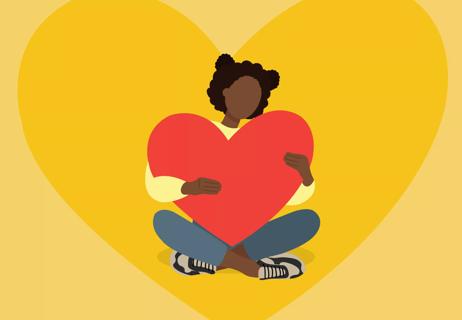Being occasionally self-indulgent has mental and physical benefits

We’ve all gone a little feral sometimes, and now we have a name for that behavior.
Advertisement
Cleveland Clinic is a non-profit academic medical center. Advertising on our site helps support our mission. We do not endorse non-Cleveland Clinic products or services. Policy
Oxford University Press (OUP), which publishes the Oxford English Dictionary, named “goblin mode” 2022’s word of the year as voted on by more than 300,000 people. That probably says a lot about our current collective state of mind, but exactly what does goblin mode mean? And is everyone out there doing OK?
Clinical health psychologist Amy Sullivan, PsyD, breaks down the meaning of goblin mode — and how it can actually benefit you.
OUP defines goblin mode as “a type of behavior which is unapologetically self-indulgent, lazy, slovenly, or greedy.” So, what does that look like? Goblin mode can look wildly different for everyone, but it usually involves discarding social norms and expectations for unruly behavior. Some examples of goblin mode include:
Advertisement
Essentially, goblin mode is a form of letting yourself go. It’s that 2 a.m. decision to shuffle to the kitchen and scrounge out the last bit of your favorite ice cream from the bottom of the pint that’s been sitting in the back of your freezer, unnoticed, for weeks. It’s going to the grocery store in your sweats and not caring who you run into in public (or what they think of you when they inevitably do). And it’s that spur-of-the-moment satisfaction you feel from grabbing junk food for lunch instead of cooking up a healthy meal.
But what’s the payoff for shedding personal responsibility and throwing caution to the wind? The term — while getting its start from a Twitter thread in 2009 — grew viral during the COVID-19 pandemic. When we were all stuck at home doomscrolling and finding new ways to cope with chaos, we began to care less about our personal appearances and more about our personal comfort and joy.
“During COVID, we learned how to cope in different ways and we’ve learned how to rest, recharge and recover,” says Dr. Sullivan. “Goblin mode is truly about taking care of ourselves in nontraditional ways.”
Goblin mode has some health benefits. In many ways, it’s our natural knee-jerk response to things like stress, conflict, red flags and trauma.
Think about it this way: When we’re stressed, overwhelmed or under siege by life’s quarrels, our sympathetic nervous system kicks in. This network of nerves activates your fight-or-flight response by triggering a number of biological processes in your body that include increasing your heart rate and breathing ability, slowing down your digestion and improving your eyesight and reflexes — all things that improve your survivability. When you experience chronic stress, anxiety or depression, your sympathetic nervous system works around the clock to protect your mind and body from the possibility of danger.
“The sympathetic nervous system is an evolutionary adaptation that helps us to increase our chances of survival in threatening situations. This system is activated as your body prepares to fight or flee, but nowadays, it’s turned on even when a person is simply stressed and not necessarily threatened. This can happen in general situations like sitting in traffic, paying bills or just having a really bad day,” explains Dr. Sullivan.
“Our minds and our bodies are so closely tied together that when we have some upheaval and we’re not settled, or we’re anxious and stressed, our sympathetic nervous system turns on and wreaks havoc on our bodies.”
Advertisement
When our stress levels are high, we can experience a number of negative effects in our bodies and our overall mental health. But when that stress subsides, our parasympathetic nervous system controls our body’s response during times of rest and allows our minds and bodies to calm down, relax and recover.
Your parasympathetic nervous system can be triggered by participating in restorative or relaxing activities like meditation, mindfulness and yoga. We can also trigger our parasympathetic nervous system by shutting down, resting, turning electronics off and doing simple activities — all things that fall into goblin mode territory.
“Goblin mode enables us how to shut down our sympathetic nervous system and go into the parasympathetic nervous system response,” says Dr. Sullivan. “It allows us to rest, recharge, rejuvenate and reconnect.”
Bad days are made up of bad moments. Sometimes, you just need to release your inhibitions in order to free yourself from a negative spiral.
“Instead of allowing ourselves to go down the rabbit hole of very negative months or weeks, I think we need to stop and take a step back,” encourages Dr. Sullivan. “We need to figure out how we’re going to restore the rest of the day, the rest of the hour, the rest of the meeting or whatever it may be that’s bothering you.”
Advertisement
Restorative activities look different for everyone, but the heart of restoration is about being kind to yourself in the way you choose to recover from certain situations. Maybe it’s as simple as deep breathing techniques or taking a nap. Maybe you’d rather leave the house to take a walk out in nature or browse one of your favorite stores. Or maybe you want to use the opportunity to close the curtains, dim the lights, grab that junk food and catch up on a show. However you choose to cope with your stress, the restorative aspect of goblin mode is dependent on not guilting yourself or feeling ashamed for how you’re responding.
“Restoring is recovering,” states Dr. Sullivan.
You can’t make a call with a dead cell phone. When you’re low on battery power, you have to find ways to rest and recharge. If you find yourself going to bed early, sleeping in or indulging in a late-afternoon nap, that’s OK. Burnout is a real problem that affects your physical and mental health, as well as your relationships with other people.
Sleep has the power to heal your mind and body and help you think clearly, especially under stress. And recharging isn’t just limited to your sleep schedule — if you don’t feel like getting together with friends or family or you’re ready to take a social media detox, that’s OK, too. Sometimes, you just need a little time to yourself in your own little goblin cave.
Advertisement
“It’s important to have space for these restorative and recharging activities in our lives so we’re not constantly burning on all cylinders,” says Dr. Sullivan. “Once we’re recharged, we can rebuild.”
What gives you joy? Is it that first scoop of mint chocolate chip ice cream? Is it cuddling up on the couch beside a scented candle and reading a good book? Or do you find comfort in rocking those super soft sweats while you take a break from your morning routine?
“Recharging is about how your body feels, but rejuvenation is more about how you bring joy back into your life,” distinguishes Dr. Sullivan.
Not sure where to start? Try journaling about how you’re feeling, what makes you happy each day and what you miss most, and then see what comes up.
“When you have purpose and meaning, that’s rejuvenating,” says Dr. Sullivan. “Rejuvenation is more for your mind, spirit and soul.”
When you’re spinning your wheels, often the way out of a negative self-talk spiral is to find ways to reconnect with who you are as a person, the people who mean the most to you and the activities you find inspiring.
“When we look at ways to manage burnout or look at ways to help people with mood disorders, depression or anxiety, we focus on connections,” notes Dr. Sullivan.
For some, reconnecting with their faith is important. For others, it may be reconnecting with a friend they haven’t hung out with in a while. You can reconnect with intangible things, too, like your love for adventure, the great outdoors or — perhaps, more importantly — your inner child.
“When we embrace our inner child, we don’t take ourselves or the world so seriously. We have the ability to experience pure joy and innocence, and we see magic in places we don’t expect,” says Dr. Sullivan.
So, that inclination you have to avoid cleaning up your messes and instead, indulge in long bouts of video games, rush to a rage room or get lost in the forest with your friends on a muddy hike? It makes sense when you consider you’ve been under a lot of stress.
“We learn as children that we can help others by playing with them or interacting with them,” says Dr. Sullivan. “Having that joyous connection with people is really important when life is tough and hard.”
“When you have difficult times, ask yourself, ‘What do I need?’” Dr. Sullivan advises. “Do you need a physical recharge? Is it emotional rejuvenation you’re looking for? Whatever you need, you do what you need to do to get your energy or spirit back.”
But if you find yourself having a hard time emerging from your cave of self-care, you may want to have a heart-to-heart chat with your inner goblin.
“When something starts to affect your ability to function, your daily life or your mental and physical health, we need to take a step back and say, ‘I’m doing too much of this,’” cautions Dr. Sullivan. “In those instances, it’s important to reach out to a mental health provider.”
By doing so, you can get help address some of the underlying causes of your stress and anxiety and find healthier coping mechanisms that boost your self-esteem and self-confidence.
Learn more about our editorial process.
Advertisement

A little research can go a long way — but only if you keep your mind open and your provider informed

Move your body, spend time with other adults and practice gratitude to help regain your sense of self

Like being your own best friend in times of trouble, self-love is an act of self-preservation

This state of mind is all about focusing on what you love and enjoy (minus the FOMO)

Silence your inner critic by treating yourself with kindness, understanding and empathy

You may need a mental shift to start caring for your physical and mental well-being

Take time to prioritize yourself, even (especially) when you’re consumed with prioritizing others

Silence that mean voice in your head by treating yourself with gentle care and respect

The best parenting style balances enforcing rules and showing plenty of love

Tips include cutting back on sugar, focusing on exercise and managing stress

It can be harder to let go when you’ve invested time, energy and emotions — but it might be the healthier choice long term